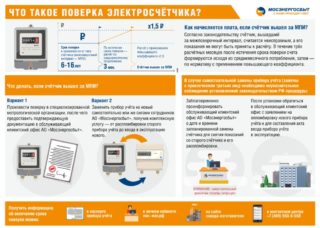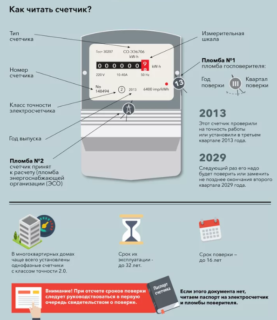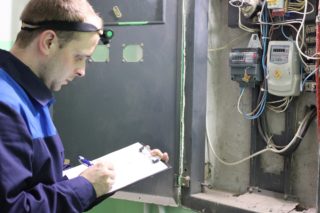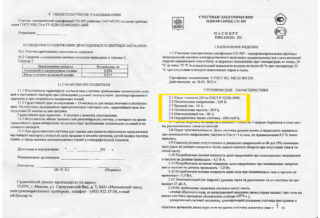An electric meter is a metering device that is designed to calculate the amount of electricity consumed in real time - it works continuously. Like any other device, electric meters wear out over time, which inevitably leads to incorrect counting and malfunction. To prevent such phenomena, it is important to comply with the technology and the timing of verification of the electric meter in the apartment.
The relevance of the verification device
Verification activities are regulated at the legislative level. In Russia, a special legislative framework has been developed that regulates the verification of meters in apartment buildings and private houses.
- Law of the Russian Federation No. 102 “On the integrity of measurements”.
- Law of the Russian Federation No. 261 "On the conservation of energy, as well as improving its efficiency."
The account of the consumed volumes of electricity is carried out using special electricity meters. They are mandatory for installation in all rooms in order to calculate the consumed kilowatts for their subsequent payment. To monitor the performance of the device provides a special event called verification.
Duration of verification of the electric meter in the apartment and the procedure
The interval between calibrations can vary between 6 and 8 years for induction mechanical devices, and for electronic meters this figure reaches 16 years. The frequency of checks depends on the modification and model of the device, all its technical characteristics should be noted in the attached passport.
There is a likelihood of an extraordinary check, which is necessary in case of loss of documentation confirming the operability of the device.
Types of verification of the electric meter at home
 Verification is a set of measures designed to determine the error of measuring instruments during their operation. There are several varieties:
Verification is a set of measures designed to determine the error of measuring instruments during their operation. There are several varieties:
- Primary verification. It is carried out by the manufacturer or when importing the meter into the country. The essence of the event is to determine the operability, the compliance of the measurement quality with the data stated in the attached passport. It is carried out once. The date of the initial inspection must be recorded in the technical passport.
- Periodic It is carried out after a certain period of time or long-term storage of the meter. It is carried out by the appropriate body of the metrological service. The main purpose of the event is to determine the degree of wear of the part and the operability of the device. They compare the actual error rates with the acceptable ones, and based on these data render their verdict.
- Extraordinary. The main reasons for its implementation are doubts about the correct display of electricity consumption, loss or damage to the technical passport, where the date of the last inspection, repair and replacement of the device was recorded.
The main objective of these measures is to compare the readings of the meter with the data of the reference device and calculate the error in percentage terms. Metrological services note that an error of no more than 10% is allowed up or down. If this value exceeds the permissible limits, replacement of the electric meter is required.
It is strictly forbidden to carry out verification to everyone, since this is the authority exclusively of employees of the metrological services or organizations accredited by them. The use of electric meters that have not passed the test or have reached the end of their useful life is prohibited.
Methods of verification of the electricity meter
For different models that are designed for accounting, the methodology may differ slightly, but in general, the event is carried out in several stages:
- Visual inspection for cracks and other mechanical damage to the glass, the case, and most importantly - the compliance of the device number, the presence of seals and its configuration.
- Strength test of an electrical insulating coating. If no damage or abnormalities were detected on the meter, this item can be skipped.
- Check for compliance with metrological parameters. It is also carried out in several stages: checking the overall operability of the device; identification of errors in percentage terms and compliance with acceptable values; determination of the susceptibility of the electric meter, as well as the absence of an independent stroke.
- In the last turn, on the basis of the data obtained, a conclusion is drawn up.
Verification is carried out by employees of metrological institutions who have undergone appropriate education and training and have access to check electric meters.
Detailed algorithm
 The verification algorithm for each counter model may vary slightly. The procedure includes a set of the following activities:
The verification algorithm for each counter model may vary slightly. The procedure includes a set of the following activities:
- They start by studying the outer shell of the case - the presence of mechanical damage and deformation, the integrity of the glass, as well as the internal parts. It is important that the completeness of the declared modification and the existing marking is consistent - this is one of the main requirements of the State Standard, neglect of it threatens with a fine or administrative liability.
- According to the requirements of GOST, the strength of the waterproofing layer is checked. You can neglect this item if the device is fully operational or has recently been installed.
- Assessment of the correct functioning of the meter. To do this, connect the device to a power source and warm up for at least 15 minutes. There is another alternative - measuring the speed of the disk and turning on the LEDs during changing the panel readings.
- During verification, metrologists must verify the absence of self-propelled. To do this, voltage is supplied to the parallel circuit (from the rated indicator of 115%), this should be carried out with the obligatory absence of current in the serial circuit and the rated voltage indicator of the power supply and its additional circuits. The verification time in this case reaches 10 minutes. This event is not carried out only if the installed electric meter, based on its design features, is not equipped with a self-propelled gun.
- Measures are also taken to identify the sensitivity threshold of the electric meter. Duration also does not exceed 10 minutes. Carried out at a nominal voltage of the parallel circuit of the meter and a similar value of the voltage of the power source in the meter.
Also, the compliance of the main and relative accounting errors is mandatory. Each device has individual indicators. The error is calculated by the method of indirect calculation of power. In the process, the use of a stopwatch, ammeter and voltmeter is mandatory. The error is calculated by comparing the voltage, load power, as well as current strength with those recorded in the technical data sheet attached to the meter.
After verification of the metering device, subject to the requirements, a seal with an impression of the verification mark must be imposed on it.
Verification of electricity meter
Information on local metrological organizations can be found in the city sales office or management company.
To carry out the complex of required measures it is not at all necessary to dismantle the device and take it to the laboratory, most often inspectors come to the house.
At the end of the work, all information is recorded in the instrument passport. Be sure to record information about the date of the visit to the employee of the metrological service, the amount of error that was identified in the process, as well as any malfunctions and violations.
If the result is negative, the employee will issue a notice confirming the inoperability of the meter, as well as its non-compliance with the established standards and the impossibility of its further operation.
If the verification period has expired, you must contact the organization that provides the service.




